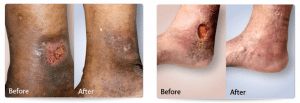Vein Ulcers: What They are and How to Treat Them

Vein ulcers are open sores that often develop around the ankle as a result of venous insufficiency in the lower leg. The sores may become quite large, can be difficult to treat and have a high recurrence rate. The good news is there are innovative treatments for vein ulcers today that greatly increase the odds of their successful elimination.
Symptoms of Vein Ulcers
Symptoms of vein ulcers may vary somewhat from patient to patient and may include:
- Discoloration of the skin before the sore appears
- Changes to the skin, such as dryness, itchiness or thickening
- Shallow sore begins to develop
- Swelling may make the skin around sore appear tight and shiny
- Discharge from the sore indicates the presence of infection
It is best to seek treatment for the first sign of a vein ulcer, even before the sore actually forms. The earlier the cause of the ulcer can be addressed, the more likely treatment of the area will be successful.
Causes of Vein Ulcers
Vein ulcers are usually caused by a vascular condition known as venous insufficiency. Veins have tiny valves inside that keep blood flowing in the same direction, back to the heart. Valves in the lower leg veins often wear out or become damaged over time, due to the extra work of pushing blood against gravity up to the heart. When these valves do not work as efficiently, blood can pool in the lower veins, restricting blood flow and resulting in leg swelling, tissue damage and vein ulcers.
Treatment Options
Treating vein ulcers usually involves a combination of healing the wound and addressing the venous insufficiency that led to the formation of the ulcer. At Advanced Varicose Vein Treatments of Manhattan, Dr. Ronald Lev offers two different treatment options:
Apilgraf – This innovative treatment uses a tissue-engineered product containing live skin cells, collagen, and protein to stimulate the body’s own healing process. Dressings are placed over the Apligraf covering to protect the wound as it heals. Dressings are changed weekly at the physician’s office until the wound is nearly healed, which generally takes a number of weeks.
Oasis – This extracellular matrix is created from natural tissue that can be absorbed into open wounds to promote healing of the area. The Oasis remains on the wound as long as necessary, allowing the wound to close and heal completely.
In addition, Dr. Lev offers a number of vein treatments to address the underlying condition that led to the venous ulcer. By eliminating varicose veins through procedures like sclerotherapy and laser treatments, healthy blood flow can be restored to minimize the risk of ulcer recurrence. To learn more about your options in vein ulcer treatment, contact Advanced Varicose Vein Treatments of Manhattan at 212-204-6501.

